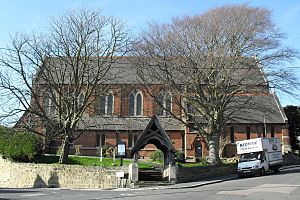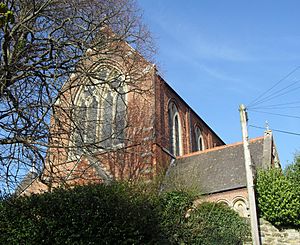St Peter's Church, St Leonards-on-Sea facts for kids
Quick facts for kids Sonrise Church at St Peter's |
|
|---|---|
| St Peter's and St Paul's Church | |

The church from the south
|
|
| 50°51′39″N 0°33′41″E / 50.8608°N 0.5614°E | |
| Location | St Peter's Road/Cornfield Terrace, St Leonards-on-Sea, Hastings, East Sussex TN37 6RA |
| Country | England |
| Denomination | Independent Evangelical |
| Previous denomination | Anglican |
| History | |
| Status | Church |
| Founded | 1883 |
| Founder(s) | Blanche E. Elliott (benefactor) |
| Events | 1 November 2011: declared redundant by Diocese of Chichester 10 February 2016: registered for the use of Sonrise Church |
| Architecture | |
| Functional status | Active |
| Heritage designation | Grade II* |
| Designated | 14 September 1976 |
| Architect(s) | James Brooks |
| Style | Early English Gothic Revival |
| Completed | 1885 |
| Construction cost | Approx. £11,000 |
| Administration | |
| Parish | St Leonards-on-Sea: Christ Church and St Mary Magdalen [sic] (until 2011) |
| Deanery | Hastings (until 2011) |
| Archdiocese | Lewes and Hastings (until 2011) |
| Diocese | Diocese of Chichester (until 2011) |
St Peter's Church is a beautiful old church located in the Bohemia area of St Leonards-on-Sea, a town by the sea in East Sussex, England. It was built a long time ago, in the 1880s, when many new homes were being built in this part of town. The church is known for its "outstanding" design, which is in the Gothic Revival style.
The church was designed by a famous architect named James Brooks. It was built by a local company called John Howell & Son. After another nearby church, St Paul's, was closed and taken down, St Peter's Church became known as St Peter's and St Paul's Church. In 2011, the church was declared "redundant" by the Diocese of Chichester, which means it was no longer needed for its original purpose. However, since 2010, it has been home to Sonrise Church, which is an independent Christian group. This historic building is very important, so it has a special heritage listing called Grade II*.
Contents
History of St Peter's Church
St Leonards-on-Sea started as a new town in 1828, created by a builder named James Burton. It grew very quickly, spreading from the seaside into the nearby valleys. As more people moved in, more churches were needed. Three Anglican churches were built early on: St Leonard's (1831), St Mary Magdalene's Church (1858), and Christ Church (1860). A fourth church, St Paul's, was built in 1868.
Building the Church
As the town kept growing, especially around the Bohemia Road area, there was a need for another church. A kind churchgoer named Blanche E. Elliott gave a large sum of money, £14,300, to help build it. The first stone was laid on August 4, 1883.
The church was built by John Howell & Son from Hastings. The design came from James Brooks, who was a very respected church architect. He was known for designing beautiful, yet affordable, churches. His original plan for St Peter's included a tall tower and spire, but these were never built.
The church was finished and opened for worship in 1885. The total cost was more than £11,000. It was given its own area, or "parish," which was taken from St Paul's Church's area. Both churches served the community for about 80 years.
Changes Over Time
In 1964, St Paul's Church was closed and taken down. This was a big loss for the area's historic buildings. After St Paul's was gone, its parish was combined with St Peter's. From then on, the church and its parish were known as St Peter and St Paul. (There is another church with a similar name, St Peter and St Paul's Church, built in 1969 in a different part of Hastings.)
In 2011, the church was officially declared "redundant" by the Diocese of Chichester. This meant it was no longer used by the Anglican church. However, since 2010, a different Christian group called Sonrise Church has been using the building. Sonrise Church started small in St Leonards-on-Sea in 2000. As it grew, it moved to bigger places, and in 2010, it moved into St Peter's Church. Sonrise Church is now an independent Evangelical church.
Architecture and Design
James Brooks was famous for designing large, cost-effective churches, especially in London. He used simple, well-balanced Gothic Revival styles, often with brick, but added interesting details. These details can be seen at St Peter's Church, even though he had a bigger budget here than for some of his London projects.
The church is built with red brick in the Early English Gothic Revival style. It has tall, narrow windows called lancet windows, which have decorative stone patterns. The walls also have some limestone, and the roof is made of slates and red clay tiles.
Inside the Church
The church's layout includes a main area called the nave and a smaller area near the altar called the chancel. These are separated by a tall arch that almost reaches the roof, making the inside feel like one large space. There are also side aisles, porches, a small chapel, and a room for the clergy called a vestry.
The upper part of the church walls, called the clerestory, has tall, paired lancet windows. These make the side aisles seem low. The baptistery, where baptisms take place, has a unique cone-shaped roof with decorative patterns. Both the front (west) and back (east) windows are made of groups of lancet windows with decorative stone work.
Inside, the walls are mostly uncovered red brick. However, in the chancel area, a beautiful stone called alabaster is used. The large pillars that separate the nave from the aisles are also made of brick with stone tops. These pillars have a unique shape that was considered very new and clever by experts like Nikolaus Pevsner.
Special Features
Some of the most impressive parts of the church are the lectern (where readings are given) and the pulpit (where sermons are delivered). These are made of pink and grey alabaster and have detailed carvings. There is also a tall, pointed screen behind the altar called a reredos, which shows a picture of the crucifixion. This was made in 1895 by Harry Hems following Brooks's designs.
Next to the church are the old church hall and vicarage (the vicar's house), which are now used as a day care center. These buildings might also have been designed by James Brooks and have similar Gothic Revival styles.
St Peter's Church Today
St Peter's Church was given a special heritage listing of Grade II* on September 14, 1976. This means it is a "particularly important" building with "more than special interest." As of 2001, it was one of 13 buildings in Hastings with this high Grade II* status.
The church's original parish covered a large part of northern St Leonards-on-Sea. This area included places like St Leonards Warrior Square railway station, Warrior Gardens, and parts of Alexandra Park.
As mentioned, the Diocese of Chichester declared the church redundant in 2011. However, Sonrise Church has been using the building since 2010. In February 2016, it was officially registered for marriages for Sonrise Church. Sonrise Church is part of the Evangelical Alliance, a group of Evangelical churches.
See also



